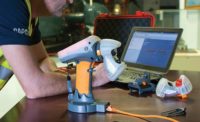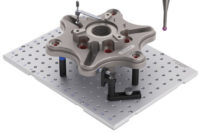
In the early 1980's, North American automakers were feeling the effects of increased competition from their Japanese counterparts. Of particular concern to U.S. manufacturers was a perceived quality gap between U.S.-built cars and Japanese-made vehicles, which was driving more consumers to purchase imported cars.
These trends spawned a renewed emphasis on quality in North American automotive production, at the same time that rapid advances were occurring in personal computers, lasers, cameras and image processing. When these areas came together to produce a new technology known as machine vision, U.S. automakers soon recognized its potential for use in improving vehicle quality.
One of the earliest automotive applications for the technology was the use of laser-triangulation machine vision sensors and specialized algorithms to perform automatic dimensional measurements aimed at quality control. Since then, the automotive industry has embraced the use of laser measurement, and its application has proliferated throughout the production process.
The power of laser-based dimensional measurement lies in its combination of speed and noncontact measurement capability. Because a large number of measurements can be performed quickly and simultaneously without touching the car's body, laser measurement systems can be placed "in process" to measure 100% of production.
The original automotive application for laser measurement was dimensional verification of fully built, unpainted, "body-in-white" automobile body structural assemblies. Each completed body-in-white passed through a measurement station to check if it was dimensionally correct. Rejected assemblies were repaired or scrapped, while acceptable assemblies continued through the process.
Today, in-process laser measurement systems are used for much more than just quality inspection. Because they can measure every part that is produced, in-process measurement systems are proving to be invaluable tools for root cause determination and process improvement. Over the past two decades, the scope of laser measurement in automotive manufacturing has grown beyond standalone, end-of-line stations to encompass nearly every process center within the automotive assembly line. Where the technology will go from here is anyone's guess, but current trends may provide an indication.
Flexible measurement
One of the most significant trends in automotive laser measurement is the growing interest in North America for flexible measurement systems. These involve mounting a laser triangulation sensor on the end of an industrial robot arm, which is then programmed to move the sensor into position to perform a number of different dimensional measurements. These systems are considered "flexible" because the robot can be programmed to measure parts with widely varying geometries.
Several forces are driving this trend toward flexible measurement systems. One is the goal to more fully use production capacity by increasing the number of different models built within a plant. If demand for minivans slows down, for instance, a plant can quickly switch over and start building pickup trucks or sedans. This increased variety in the model mix requires a measurement system that is versatile enough to handle different geometries.
Another impetus is the desire of automakers to have multiple measurement routines for different situations. For instance, BMW's Spartanburg, SC, plant measured a large number of checkpoints during the low-volume phase of a recent product launch and now makes a smaller number of measurements during full production.
Unfortunately, with flexibility comes complexity. A flexible measurement system includes many components not found in a fixed sensor system, including the robot itself, temperature compensation software for the robot, robot calibration and others. With all of these additional components, users can lose sight of the fact that the system is first and foremost a measurement system.
The best flexible measurement systems are those that integrate the many different components so they are transparent to the user. In other words, the software interface for defining measurement checkpoints, teaching algorithms, configuring temperature compensation, performing calibration, establishing communications and analyzing data should be consistent and easy for the user to navigate. Similarly, the system should work with all of the major brands of industrial robots and offer a robust set of tools for performing the necessary measurements. Finally, a truly flexible measurement system must mix fixed and robot-mounted sensors to create hybrid systems combining the speed of fixed sensors with the versatility of the flexible system.
Spread 'em out
The original application of laser measurement in automotive manufacturing was a single station at the end of a body-in-white assembly line that checked each part and prevented any defective parts from continuing in the process. However, because the in-process station measures every assembly being produced, it also becomes a barometer of the manufacturing process itself. The information is critical for root cause determination and variation reduction.
Most defective parts are not anomalies but rather the result of some change in the manufacturing process. When defective parts are detected, the most important question to answer is, "What is the origin of this error?"
To more quickly determine the answer, manufacturers over the past decade have installed more measurement systems in their processes to aid root cause analysis. Instead of a single station to measure the body-in-white assembly, many automakers measure the completed underbody, body sides, framed body, doors and hoods. This step has helped manufacturers more quickly isolate problems at the subassembly level.
But even that is no longer enough. Each subassembly is made up of numerous individual components that are assembled and welded together.
The current trend is to strive for complete "diagnosability" of manufacturing processes to support very fast root cause determination. To do so requires the distribution of sensors throughout a manufacturing process rather than at a dedicated measurement station. For instance, some Audi assembly plants in Germany contain more than 25 laser measurement stations in their body assembly processes. Analytical models have been developed recently that determine what features to measure and where to measure them to obtain the most useful information with the smallest investment in equipment.
Faster changeovers
Because faster is better, the automotive industry is now using in-process laser measurements to enable shorter product launch times. In past decades, a new model launch meant shutting down an assembly plant for four to six weeks and completely replacing old tooling and equipment. After several weeks, production of the new model ramped up, but it took another few weeks to reach full production volumes. This changeover schedule meant that the plant did not generate any revenue from the time the last vehicle of the old model was produced until the first saleable vehicle of the new model rolled off the line.
In today's product launch cycle schedules, there is immense pressure to compress launch times to minimize the plant downtime and maintain a more consistent revenue stream.
This has driven automakers to use laser measurement sooner in the launch phase. Previously, the in-process laser measurement system was one of the last stations in the plant to be functional, because it was considered nonessential for building cars. Also, representative sheet metal parts required for aiming sensors were often not available. As a result, assemblies built during ramp-up were not measured in-process and dimensional data were only available from time-consuming coordinate measuring machines.
Today, automakers try to get the measurement system functioning before the first part is built. This is possible because of the "sensor lay-in design" and "virtual aiming" capabilities of some laser systems. Sensors are now mounted and aimed exactly to the correct point in space without having representative parts available. When the first part is built, the only remaining step is to teach the measurement algorithms. DaimlerChrysler has begun using this methodology to obtain immediate feedback on the quality of its first production assemblies. This enables faster debugging of the manufacturing system, resulting in shorter launch times.
Beyond OEMs
For years, the major automotive OEMs were the only users of in-process laser measurement, while their suppliers used more traditional methods of quality control such as statistical sampling with off-line measurement devices. Today, however, the fastest growing market segment for laser measurement is non-OEM manufacturers, especially those providing components to automotive OEMs. This is largely because of the trend among OEMs to rely more upon their suppliers to provide major subassemblies such as truck frames, motor compartments and instrument panels.
In some cases, the adoption of in-process laser measurement is required by the OEMs. However, a growing number of automotive suppliers, such as The Budd Co. (Troy, MI), Dana Corp. (Toledo, OH) and Tower Automotive Inc. (Grand Rapids, MI), are using in-process laser measurement because it makes them more competitive by ensuring quality and helping them control costs through process variation reduction.
New Uses
The automakers themselves have also begun to use laser-based sensors for more specialized applications. Some OEMs are using the technology to measure gaps and flushness of automobile body panels, for example, while other carmakers are using laser systems to validate the pre-bending of tubes for hydroforming.
The move toward automated gap and flush measurement results from a growing emphasis on the "fit-and-finish" quality of automobiles. The size of the gaps between body panels such as the hood and fenders, fenders and doors or deck lids and quarterpanels are increasingly scrutinized by consumers. The flushness of adjacent body panels is closely examined as well. These body fit characteristics not only affect customer perceptions of vehicle quality, but they also affect warranty claims for issues such as water leaks and wind noise. Some new laser measurement systems automatically measure these critical fit characteristics on fully assembled vehicles. The resulting information is provided to body fitters, who then make the correct adjustments in the right place to achieve uniform gaps and flushness between panels.
Laser measurement is also being used in the pre-bending of tubes for hydroforming manufacturing processes. Hydroforming -- the forming of parts using water pressure -- is becoming more common in the production of complex structural members such as truck frames or underbody rails for cars. Before a part can be hydroformed into a complex part, it needs to be bent into a shape that will fit in the hydroforming die. If the incoming part is not correctly pre-bent, it can damage an expensive hydroform die and stop production. Automotive supplier Magna International Inc. (Aurora, ON) uses a laser measurement system with specialized algorithms and complex relationships to validate the pre-bending of tubes at a plant that produces truck frames. In some cases, the measurement information is even used as closed-loop feedback for the bending device to control the bending process.
During the past 20 years, the use of laser measurement systems in automotive quality control has moved well beyond its original role in body-in-white dimensional verification at the end of an assembly line. Today, the technology is proliferating throughout the production process, and is becoming increasingly important for tasks including root cause determination, process improvement and closed-loop process control. Given current trends and additional developments in the works, the next 20 years are likely to see further expansion in the use of this versatile technology-both by the automotive OEMs as well as by their suppliers.
TECH TIPS
- Laser-based dimensional measurement combines speed and noncontact measurement capability, enabling its use in-process to quickly and simultaneously take a large number of measurements for 100% of production.
- For flexible measurement, a laser triangulation sensor is mounted on the end of an industrial robot arm, which is then programmed to move the sensor into position to perform a number of different dimensional measurements.
- New uses of laser measurement technology include measuring gaps and flushness of automobile body panels, and validating the correct pre-bending of tubes for hydroforming.

